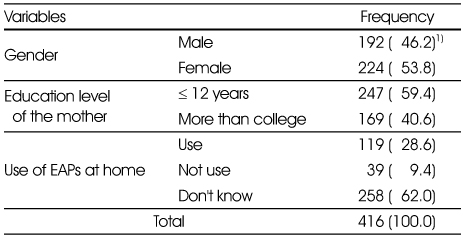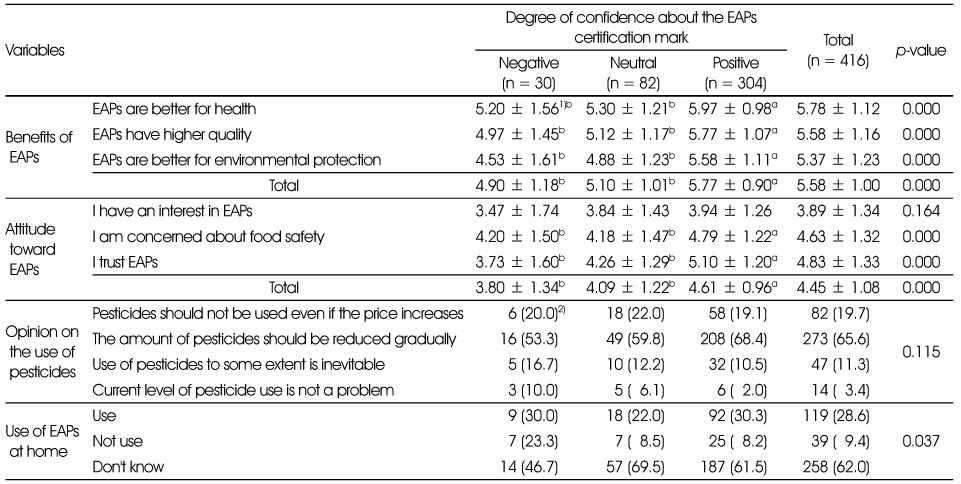References
1. Chang HS, Lee MJ. The perception for management of school foodservice using of environmentally friendly agri-cultural products of elementary school children's mothers in Gunsan. Korean J Community Nutr 2008;13(6):867–878.
2. Choi MK, Seo HC, Baek SH. The influence of environment-friendly agricultural products (EAPs) perception of parents in Chung-buk area on EAPs consumption behavior. Korean J Food Nutr 2010;23(2):269–275.
3. Ducan DW, Broyles TW. An evaluation of student and perceptions toward agriculture before and after attending a governor's school for agriculture. J Southern Agric Educ Res 2004;54(1):280–292.
4. Hong YG, Song IS. A study of cases of ethical consumption in the analysis of purchasing motives of environmnetally-friendly agriculture products. Consumption Cult Study 2008;11(3):23–42.
5. Honkanen P, Verplanken B, Olsen SO. Ethical values and motives driving organic food choice. J Consumer Behav 2006;5(5):420–430.
6. Jeong JH, Kim EJ, Kim MH, Choi MK. Perception of eco-friendly agricultural products and food service satisfaction of elementary and middle school students according to eco-friendly food service day in Chungnam. J Korean Soc Food Sci Nutr 2013;42(1):114–119.
7. Joshi A, Azuma AM, Feenstra G. Do farm-to-school programs make a difference? Findings and future research needs. J Hunger Environ Nutr 2008;3(2):229–246.
8. Kim IJ, Lee JH. The housewives' purchase behaviors on environment-friendly agricultural products in Daejeon area. Korean J Community Nutr 2011;16(3):386–397.
9. Kim NR, Cho YS, Kim SA. Satisfaction and recognition level of environment-friendly agricultural products in Cheongju area. Korean J Community Nutr 2011;16(1):75–85.
10. Kim SH, Jeong DW, Kim GH. Analysis of the relationship among image, awareness, public confidence of certificate mark for environment-friendly agricultural products, and purchase intention. J Foodserv Manage 2012;15(6):359–383.
11. Kim SO, An KW, Kim MH, Shim JH. Evaluating some influential factors on consumers' purchasing decisions of environment-friendly agricultural products (EAPs) using importance-performance analysis (IPA). Korean J Org Agric 2007;15(4):339–353.
12. Kim SS. A study on consumer's attitude for food safety and purchase of environment friendly agricultural products. J Korean Home Manage Assoc 2007;25(6):15–32.
13. Kwak MJ, Kim KN. Perception and consumption of Environment-friendly farm products (EP) among the parents of children in the schools where EP had been used or never been used in their foodservice. J Hum Ecol 2012;16(1):85–94.
14. Lee SH, Han SB, Do HO, Seo KD. The effect of hallmark of the environment friendly agricultural products on the consumer value and purchase intention: Centering around the moderating effect of regulatory focus and construal level. Digit Policy Res 2011;9(4):143–156.
15. Lee YS, Lee NO, Ko SH. A survey on use of environment-friendly agricultural products for school food service by dietitians in Chungnam province. Korean J Community Nutr 2009;14(5):556–564.
16. Lee YS, Park MJ. Parental perception and satisfaction with environment-friendly agricultural products used for school foodservice in elementary schools in Daejeon. Korean J Food Cult 2008;23(6):737–747.
17. Magnusson MK, Avrola A, Hursti UK, Aberg L, Sjödén PO. Choice of organic foods is related to perceived con-sequences for human health and to environmentally friendly behaviour. Appetite 2003;40(2):109–117.
18. Michaelidou N, Hassan LM. The role of health consciousness, food safety concern and ethical identity on attitudes and intentions towards organic food. Int J Consum Stud 2008;32(2):163–170.
19. Ministry of Education, Science and Technology. Instructions for student health promotion 2012 Seoul: Ministry of Education, Science and Technology; 2012. p. 34–45.
20. National Agricultural products quality management Services. Agricultural products standardization management 2012. cited 2013 April 20. Available from
http://www.naqs.go.kr.
21. Oh YM, Kim MH, Sung CJ. Effects of school lunch program on nutritional knowledge and attitude, and dietary behavior of Korean middle school students. Korean J Community Nutr 2005;10(2):163–173.
22. Ryu JH, Rho JO. The consumption behavior and perceptions of environment-friendly agricultural products by university students in Korea. Korean J Food Nutr 2011;24(1):101–110.
23. Ryu MJ, Suh JS, Lyu ES. A perception of dietitians for using imported foods and pro-environment farm products for elementary school foodservice operations in Busan. J Korean Diet Assoc 2004;10(4):452–466.
24. Sung MJ, Choi HS, Chang KJ. Perceptions on environment and environment-friendly agricultural products of college students in Seoul and Incheon area. J Korean Soc Food Sci Nutr 2008;37(3):317–324.
25. Yang IS, Cha JA, Shin SY, Park MK. Foodservice management 2nd edth ed. Paju: Kyomunsa; 2008. p. 38–46.






